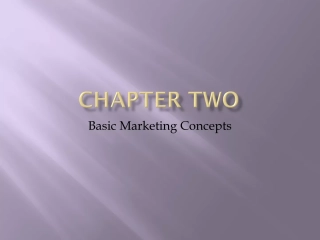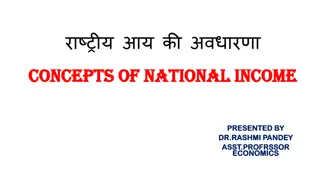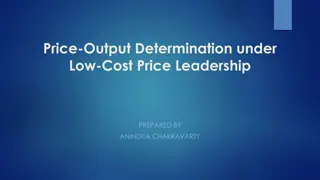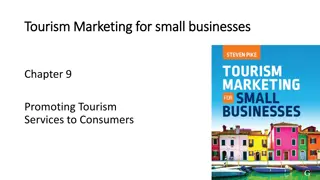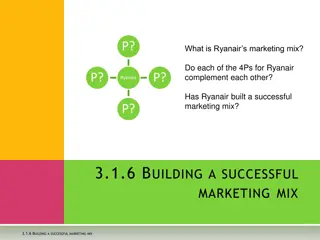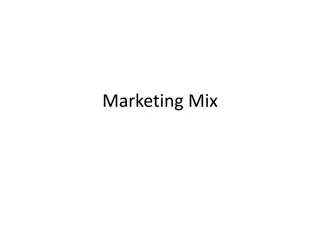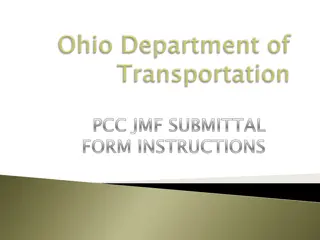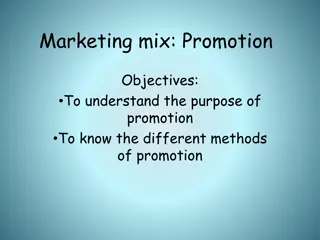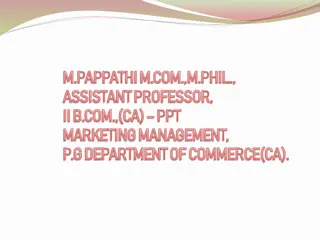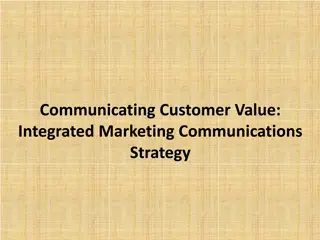Overview of Marketing Mix: Product, Price, Place & Promotion
Marketing mix, comprising product, price, place, and promotion, plays a crucial role in achieving marketing objectives. This comprehensive strategy involves decisions on product design, pricing, market placement, and sales promotion to influence consumer behavior and sales. Learn about the key elements and characteristics of the marketing mix as defined by experts like Philip Kotler and E. Jerome McCarthy.
Download Presentation

Please find below an Image/Link to download the presentation.
The content on the website is provided AS IS for your information and personal use only. It may not be sold, licensed, or shared on other websites without obtaining consent from the author.If you encounter any issues during the download, it is possible that the publisher has removed the file from their server.
You are allowed to download the files provided on this website for personal or commercial use, subject to the condition that they are used lawfully. All files are the property of their respective owners.
The content on the website is provided AS IS for your information and personal use only. It may not be sold, licensed, or shared on other websites without obtaining consent from the author.
E N D
Presentation Transcript
The elements of marketing mix have been classified under four heads product, price, place and promotion. That is why marketing mix is said to be a combination of four P s. Decisions relating to the product includes product designing, packaging and labeling, and varieties of the product. Decision on price is very important because sales depend to a large extent on product pricing.
Whether uniform price will be charged or different prices will be charged for the same product in different markets are examples of decision pertaining to the price of the product. The third important element is place, which refers to decision regarding the market where products will be offered for sale. Promotion involves decisions bearing on the ways and means of increasing sales. Different tools or methods may be adopted for this purpose. The relative importance to be attached to the various methods is decided while concentrating on the element of promotion in marketing mix.
In short, marketing mix involves decisions regarding products to the made available, the price to be charged for the same, and the incentive to be provided to the consumers in the markets where products would be made available for sale. These decisions are taken keeping in view the influence of marketing forces outside the organization (e.g., consumer behavior, competitors strategy and government policy).
Definition: According to Philip Kotler, marketing mix is the mixture of controllable marketing variable that the firm uses to pursue the sought level of sales in the target market
Therefore, the marketing mix indicates the appropriate combination of four P s product, price, promotion, and place for achieving marketing objectives. The components are also known as marketing mix variables or controllable variables as they can be used according to business requirements. In 1960, E. Jerome McCarthy in his book, Basic Marketing, popularized a four-factor classification, the so-called four P s product, price, place, and promotion.
Characteristics/Features/ Nature of Marketing Mix:
Marketing mix is the crux of marketing process: Marketing mix involves many crucial decisions relating to each element of the mix. The impact of the mix will be the best when proper weight age is assigned to each element and they are integrated so that the combined effect leads to the best results.
Marketing mix has to be reviewed constantly in order to meet the changing requirements:
The marketing manager has to constantly review the mix and conditions of the market and make necessary changes in the marketing mix according to changes in the conditions and complexity of the market.
4. Changes taking place within the firm also necessitate changes in marketing mix:
Changes within the firm may take place due to technological changes, changes in the product line or changes in the size and scale of operation. Such changes call for similar changes in the marketing mix
3. Changes in external environment necessitate alterations in the mix: Changes keep on taking place in the external environment. For many industries, the customer is the most fluctuating variable of environment. Customers tastes and preferences change very fast. Brand loyalty and purchasing power also change over a period. The marketing manager has to carry out market analysis constantly to make necessary changes in the marketing mix.
5. Applicable to business and non-business organization: Marketing mix is applicable not only to business organizations but also to non-business organizations, such as clubs and educational institutions. For instance, an educational institution is expected to provide the right courses (product), charge the right fees (price), promote the institution and the courses, and provide the courses at the right place.
7. Concentrates on customers: A thorough understanding of the customer is common to all the four elements. The focus point of marketing mix is the customer, and the marketing mix is expected to provide maximum customer satisfaction
The four major ingredients of the marketing-mix are described below:
In developing the right product, you have to answer the following questions: What does the client want from the service or product? How will the customer use it? Where will the client use it? What features must the product have to meet the client s needs? Are there any necessary features that you missed out? Are you creating features that are not needed by the client? What s the name of the product? Does it have a catchy name? What are the sizes or colors available? How is the product different from the products of your competitors? What does the product look like?
A product is any good or service that consumers want. It is a bundle of utilities or a cluster of tangible and intangible attributes. Product component of the marketing- mix involves planning, developing and producing the right type of products and services. It deals with the dimensions of product line, durability and other qualities. Product policy of a firm also deals with proper branding, right packaging, appropriate colour and other product features. The total produce should be such that it really satisfies the needs of the target market. In short, product-mix requires decisions with regard to (a) size and weight of the product, (b) quality of the product, (c) design of the product. (d) volume of output, (e) brand name, (f) packaging, (g) product range, (h) product testing, (j) warranties and after sale services, etc.
2. Price: Price is an important factor affecting the success of a firm. Pricing decisions and policies have a direct influence on sales volume and profits of business. Price is, therefore, an important element in the marketing-mix. In practice, it is very difficult to fix the right price. Right price can be determined through pricing research and test marketing.
A lot of exercise and innovation is required to determine the price that will enable the firm to sell its products successfully. Demand, cost, competition, government regulation, etc. are the vital factors that must be taken into consideration in the determination of price. Price-mix involves decisions regarding base price, discounts, allowances, freight payment, credit, etc.
3. Promotion: Promotion component- of the marketing-mix is concerned with bringing products to the knowledge of customers and persuading them to buy. It is the function of informing and influencing the customers. Promotion-mix involves decisions with respect to advertising, personal selling and sales promotion. All these techniques help to promote the sale of products and to fight competition in the market. Advertising is a major tool used to communicate a message (called advertising copy) through; newspapers, magazines, radio, television and other media of advertising. Advertising component of the promotion- mix requires several decisions with regard to the theme of advertising, the media to be used, the advertising budget, etc. Large firms employ advertising agencies and specialists to run advertising campaigns and to prepare individual advertisements.
. Distribution:
Here are some of the questions that you should answer in developing your distribution strategy: Where do your clients look for your service or product? What kind of stores do potential clients go to? Do they shop in a mall, in a regular brick and mortar store, in the supermarket, or online? How do you access the different distribution channels? How is your distribution strategy different from your competitors? Do you need a strong sales force? Do you need to attend trade fairs? Do you need to sell in an online store?
Packaging Packaging means the way your product or service looks from the outer part. One should remember that customer gets affected and makes their views about the product by looking at the way of packaging. If packaging forms fine impression on the customer it can accelerate the sales without a doubt. The layout and designing of the product from outside plays an important role in the sales.
This element of the marketing-mix involves choice of the place where products are to be displayed and made available to the customers. It is concerned with decisions relating to the wholesale and retail outlets or channels of distribution. The objective of selecting and managing trade channels is to provide the products to the right customer at the right time and place on a continuing basis. In deciding where and through whom to sell, management should consider where the customer wants the goods to be available. A manufacturer may distribute his goods through his own outlets, he may employ wholesalers and retailers for this purpose. Irrespective of the channel used, management must continuously evaluate channel performance and make changes whenever performance falls short of expected targets. In addition, management must develop a physical distribution system for handling and transporting the products through the selected channel.
In the determination of distribution-mix or marketing logistics, a firm has to make decisions with regard to the mode of transporting of goods to middlemen, use of company vehicles or a transporter, the route over which the goods are to be moved, type of warehouses where the goods are to be stored, etc.
Process The process is an integrated buying exposure. From the prime segment of contact, generally the network or website, to distribution of the good or service. Nonetheless, the process doesn t block there, because there s the post sales service, and creating decent relations with customers even after the purchasing process. One of the prime ideas to a good buying system is considered to be the speed. This is chiefly authentic when it comes to transmission of products selected and ordered by the Internet. Keeping customers learned side by side way is an impressive style to enhance the experience of customer.
Physical Evidence Physical Evidence also indicates about the experience of ultimate customers. A customer does not hold the proper knowledge and apprehension about the product when he or she buys a product for the first time. One requires to provide the consumers with physical evidence that can initiate the confidence in them. It can be a transparent contact us page on the suppliers website that helps the buyers to convey their message or query related to their experience with the usage of particular good or service
Determining the Marketing-Mix: The purpose of determining the marketing is to satisfy the needs and wants of the customers in the most effective and economical manner. As the needs of the customers and the environmental factors change, the marketing-mix also changes and it cannot remain static. Marketing-mix is, thus, a dynamic concept.
1. Identification: First of all, the marketing department must identify the target customers to whom the sales are to be made. 2. Analysis: Once the target market is identified, the next step is to discover and understand the needs and desires of the customers. Marketing research is used in locating and analyzing the target market. It is necessary to know the number, location, buying power and motives of customers. In addition, the nature of competition, dealers behaviour and government regulations must be analysed. 3. Design: On the basis of the knowledge obtained through identification and analysis, an appropriate mix of product, price, promotion and channel is designed. Design involves not only the determination of each component but the proper integration of individual variables so that they reinforce one another.
4. Testing: It is desirable to make a test run of the marketing-mix designed by the marketing department. The designed mix may be used in a small group of customers. The reaction of customers will indicate the adjustments required in the mix. 5. Adoption: After the necessary modifications, the marketing-mix is adopted and put into use. The adopted mix should be evaluated from time-to-time and it must be adapted to changes in the environment of business.
4C's - Consumer-oriented model of marketing Mix Consumer - In this model the Product is replaced by Consumer. Marketers focuses more on consumer satisfaction. The product is designed and produced keeping in consideration the requirements of consumer. Cost - Price is replaced by Cost. Here the cost refers to the total cost of owning a product. It includes cost to use the product, cost to change the product, and cost of not choosing the competitor's product.
Communication - Promotion is replaced by Communication. Communication includes advertising, public relation, personal selling, and any method that can be used for proper, timely, and accurate communication between marketer and consumer. Convenience - Place is replaced by Convenience. it focuses on ease of buying, convenience in reaching to the store/product, and convenience in getting product information.


